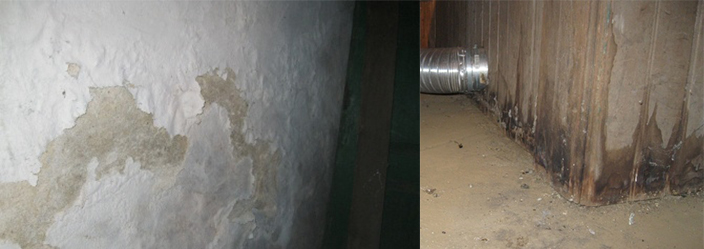OUR GALLERIES

Wet or damp basements are very problematic for homeowners because not only do damp basements emanate unpleasant odors and cause molds; they also pose a risk of causing water damage to your furniture and electronic appliances. The build-up of excessive moisture in basements will eventually lead to the weakening of your home’s foundation. It’s time to do something about it so you can maximize the space you have.
First things first, you need to find what and where the moisture comes from. Read on and learn simple tests to help you track the source.
Look Around – You don’t have to do too much to spot the source of the dampness. You just need to use your eyes and look around for any signs of wetness. The first things to check are the concrete floors and the walls. These are where moisture created by the wet ground surrounding your basement will usually come through. Look for any visible signs of dampness and white marks composed of white crystal like material. This material is call efflorescence. It is made of the minerals left on a surface when water dries out.
No Visible Signs – Sometimes you won’t be able to pinpoint the source by looking around because there are no visible signs available. In this case, you should attach a sheet of plastic with the use of duct tape to the floor near an outer wall. Do the same thing to the lower half of the exterior wall. Let the day pass then remove the plastic sheets. Check if you find any moisture created in the areas where you left the plastic sheets or if the underside of the plastic is damp.
Use a Dehumidifier – Home improvement stores now offer inexpensive dehumidifiers. Get yourself one and install it in your basement. This way you can control the dampness and minimize the odors in your basement. If you can smell a musty odor, you should scrub the walls and remove or replace anything that may cause this smell like damp boxes and old newspapers and books.
Regular Cleaning – Simply cleaning your gutters and downspouts can make a big difference. Regularly check for any debris and remove them to avoid clogging. If possible, channel your gutters and downspouts to at least six feet away from the foundation of your house.
What you really need to do is to waterproof the inside of your basement walls and floors. Waterproofing the exterior foundation wall will not get rid of the excess water but instead redirect it. Nature can’t be controlled and humidity or flooding may happen.
Some water proofing companies offer basement sealing services from the inside. This process is meant to completely eliminate humidity, ground water entry and musty odor. You may also purchase waterproofing sealants meant for the inside of the basement by visiting your local home improvement stores. Make sure to buy sealants that are non-flammable, non-hazardous and solvent-free.
You can apply this sealant yourself. Just apply a high quality liquid rubber coating to the walls and floors as a primer. Ask the store for good liquid rubber base (LRB) and thickening activator (TAV) and use these to seal all seams, cracks, holes and joints on the walls and floors. Apply another coating of the liquid rubber coating then leave it to dry for at least one day. This will leave a thick layer of watertight rubber lining to protect the inside of your basement from moisture. You can perform this process to permanently waterproof walls made of concrete, treated wood, or stone.
Having a waterproof basement can be very advantageous. You don’t have to worry about maintenance too much and you can make use of the available space for other purposes. Your basement can now be used for storage or could even be converted into another bedroom.
